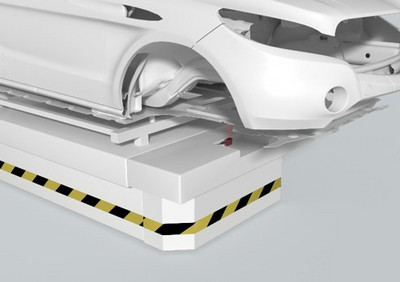The body shop
Hundreds of individual parts are assembled to form a vehicle body.
Vehicle body construction is the most automated part of automobile manufacturing. Welding, flanging and lasering as well as riveting and screwing and – increasingly – gluing are typical work processes. Robot cells, collaborative robots and conveyor systems such as skids or electrical monorail systems determine the processes.
The factory of the future is characterized by even more flexible manufacturing concepts. A large variety, just-in-time material provision and the cushioning of peak demand are required. Storage areas and production are separated. Assembly occurs in flexible cell structures. In between, automated guided vehicles (AGV) transport materials.
Our sensors are used for a wide range of applications in the body shop. Safety laser scanners safeguard AGVs and supply data for their navigation. Sensors for presence and position control ensure smooth processes and our safety sensors guarantee the necessary machine safety.





















